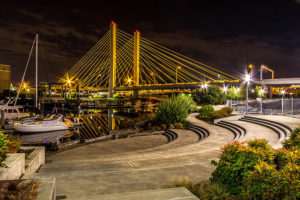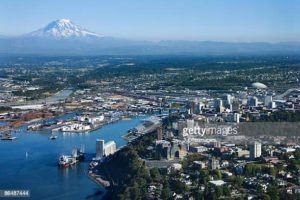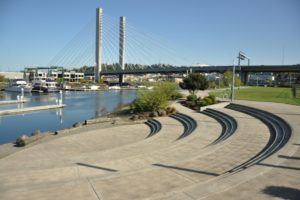TACOMA BRINGS CITY WATERWAY BACK TO LIFE
 Tacoma Environmental Services Project Manager Mary Henley beams like a proud parent when speaking about her baby’s 12th birthday.
Tacoma Environmental Services Project Manager Mary Henley beams like a proud parent when speaking about her baby’s 12th birthday.
And why shouldn’t she, Henley and her cohorts have taken one of the most polluted waterways in the nation and turned it into a key asset in the revitalization of downtown Tacoma over the past two decades.
It’s actually been a little more than 12 years since Tacoma completed the $105-million historic cleanup in 2006 of the Thea Foss Waterway, commonly known as the “City Waterway,” the north-south Commencement Bay inlet separating the downtown business and retail areas from the Port of Tacoma.
During those 10+ years, the Thea Foss Waterway has been relatively pollution free per ongoing monitoring and testing by the city, EPA, and others.
And, it may be the only time the waterway has been this clean since Nicolas Delin constructed a sawmill in 1852 powered by water on a creek near the head of Commencement Bay.
A HISTORY OF INDUSTRUAL POLLUTION
Following in Delin’s footsteps, the Northern Pacific Railroad established their western terminus here in the late 1800’s to take advantage of the deep waters of Commencement Bay, ideal for shipping and large-scale industries that fueled the growth of Tacoma around the port and surrounding shoreline over the next 100 years.
Foss inlet itself was named after Thea Foss, who founded Foss Maritime in 1889 on the waterway, providing everything from rowboats to steam tugs. Foss Tug quickly became the main tug service on Puget Sound and now is the largest on the Pacific Coast.
In 1919, the Port of Tacoma was officially established to capture Panama Canal traffic and brought the Milwaukee Railroad to further trade into what is now the largest port in the state of Washington.
Sawmills, paper pulp plants, ship builders, granaries, fish processing plants, rail yards, container and cargo shipping, oil refining, chemical processing, coal gasification, and even one of the largest copper smelters in the nation made the Port and Tacoma area home over the past 100+ years.
“Tacoma was a blue-collar town from the very beginning,” Henley noted. “People did what they needed to do to create jobs and feed their families.”
Unfortunately, that meant dumping their industrial waste and sewage straight into the waterways and Commencement Bay, figuring it would all wash out into Puget Sound and the ocean rather than accumulating to the point that by 1983 the Environmental Protection Agency (EPA) had deemed it one of the nation’s most polluted waterways, placing it on the Super Fund Pollution Clean-Up list.
 The EPA action came as the result of a 1981 U.S. Army Corps of Engineers study estimation that more than 2-million cubic yards of Commencement Bay sediment was contaminated with a long list of chemicals and pollutants in the waterways, including: Phthalates (chemicals used to make plastic, detergents, solvents); petroleum-based products; Polychlorinated Biphenyls (chemicals used as coolants and lubricants in electrical equipment); Phenols (coal-tar byproducts used in plywood adhesive, construction, automotive and appliance industries); pesticides; and a host of metals (arsenic, cooper, lead, mercury and zinc).
The EPA action came as the result of a 1981 U.S. Army Corps of Engineers study estimation that more than 2-million cubic yards of Commencement Bay sediment was contaminated with a long list of chemicals and pollutants in the waterways, including: Phthalates (chemicals used to make plastic, detergents, solvents); petroleum-based products; Polychlorinated Biphenyls (chemicals used as coolants and lubricants in electrical equipment); Phenols (coal-tar byproducts used in plywood adhesive, construction, automotive and appliance industries); pesticides; and a host of metals (arsenic, cooper, lead, mercury and zinc).
“We had a little bit of everything in the contaminated sediment in the bay and our waterways,”
Henley recalls. “It was not a pretty sight.”
DOWNTOWN TACOMA BEGINS TO EVOLVE
Compounding the issue was the fact the waterway had gone from a thriving industrial and warehousing area in the early and mid-1900’s to an area that was mostly abandoned by 1981 as industrial use dwindled in the area due to growing environmental concerns.
Though the EPA sounded the alarm in the mid-1980’s, it was not until 1994 when the City of Tacoma made the fortuitous decision to take the lead in developing a plan to clean up the Thea Foss and Wheeler-Osgood waterways as part of a larger Commencement Bay Superfund site.
“It would not have happened if the city had not stepped up to the plate,” Henley admits. “Many of the superfund sites in the country did not get a lot of cooperation between the state, federal, and local governments, let alone the industrial users that could be held accountable for some of the costs.”
That did not happen in Tacoma as the city forged a unique plan and agreements to pay the $105-million required to clean up the Thea Foss and Wheeler-Osgood waterways after conducting an aggressive investigation of the sources and extent of contamination by taking and testing hundreds of sediment and water samples at various debts throughout the waterway.
“Once we identified what was in the water and sediments, then it was all about finding the sources by literally going business-by-business, drain-by-drain,” Henley explained.
Based on the extensive testing, present and project future uses of the waterways, the city developed a plan that was accepted by the EPA where Tacoma would pay for 80 percent of the cleanup though collection of city surface water fees ($56.5-million), Washington State Department of Ecology ($24.5-million) and Washington State Department of Natural Resources ($3.7-million) grants. Nearly 20 percent of the cleanup was paid by PacificCorp and Puget Sound Energy ($7.3-million) and private contributions from other “responsible parties” ($13-million).
THE CLEAN-UP BEGINS
With an approved plan and funding in place, more than 425,000 cubic yards of contaminated sediments were dredged from the waterways from 2002 to 2006 and placed behind a containment berm in the nearby St. Paul Waterway, while other areas were capped with clean sediments.
Habitat restoration sites were also constructed at North Beach, Puyallup River Channel, Middle Waterway Tideflats, and the Hylebos Creek mitigation site, along with habitat-friendly shoreline enhancements along the Thea Foss Waterway.
“I guess you might say our goal was to take this lemon and make lemonade,” Henley mused.
That could be an understatement for those that have seen Tacoma grow and change over the past 50 years, as the Thea Foss Waterway has gone from mostly industrial to commercial and residential uses under the guidance of the Foss Waterway Development Authority (FWDA), which now oversees the commercial buildout of this now-thriving area.
Today, the mixed-used area includes housing, retail shops, restaurants, museums, parks, public esplanade, and a marina with more than 900 private boats moored there.
“It has obviously been very good for the city’s tax rolls,” Henley suggested. “It proves that environmental responsibility can also make a lot of economic sense. The cost of cleaning up the Thea Foss is money well spent.”
KEEPING IT CLEAN
Though the waterway has been cleaned up and transformed into a place where Tacoma residents can “live, work, and play,” Henley and the city’s Environmental Services Department plan to keep it that way. That’s why the city monitors the waterway remediation through chemical monitoring, visual observations, and underwater surveys.
“We’re not done, well never be done,” Henley said of the city’s ongoing monitoring of the waterways and Commencement Bay.
While most the major polluting industries and sources are gone, the biggest threat to the Thea Foss Waterway now is the storm water from more than 6,000 acres in the city of Tacoma that drains untreated into the waterway.
To combat and mitigate the effects of untreated storm water, Tacoma’s Environmental Services Department has developed one of the more sophisticated monitoring systems in the nation to help deal with the pollution that comes from storm runoff, soapy water, oil and fertilizers that come from residential areas through the city’s 18,000 storm drains and 500 miles of pipes.
Based in the Center For Urban Waters located on the Thea Foss Waterway, Tacoma Environmental Service has a team of five engineers that regularly test the storm water through a series of sediment traps in selected drains and outfalls into the waterway.
Besides the usual road oils, the system has helped the city detect abnormal amounts of pollution from a variety of sources, including a homeless encampment near the St. Paul waterway habitat area, from a laundry facility at the Northwest Detention Center, even the parking lot at the Tacoma News Tribune, which has since been replaced because the old one had coal tar in it.
“It is a very sensitive monitoring system, most of the time we can easily trace the source of the pollution entering the storm water,” Henley noted.
Trouble with storm water pollution, is most of it comes from oil that leaks from automobiles, soapy water from washing your car, dog poop that is not scooped, and the natural breakdown of plastics that are common in everything from the siding on a house to the plastic trash that makes its way into the storm drains.
“We are at a point now where our main push is educating the public on what they can do to keep these forms of pollution from entering the waterways in the first place,” Henley concluded. “I think we can all agree it is in everyone’s best interests to do so.”
